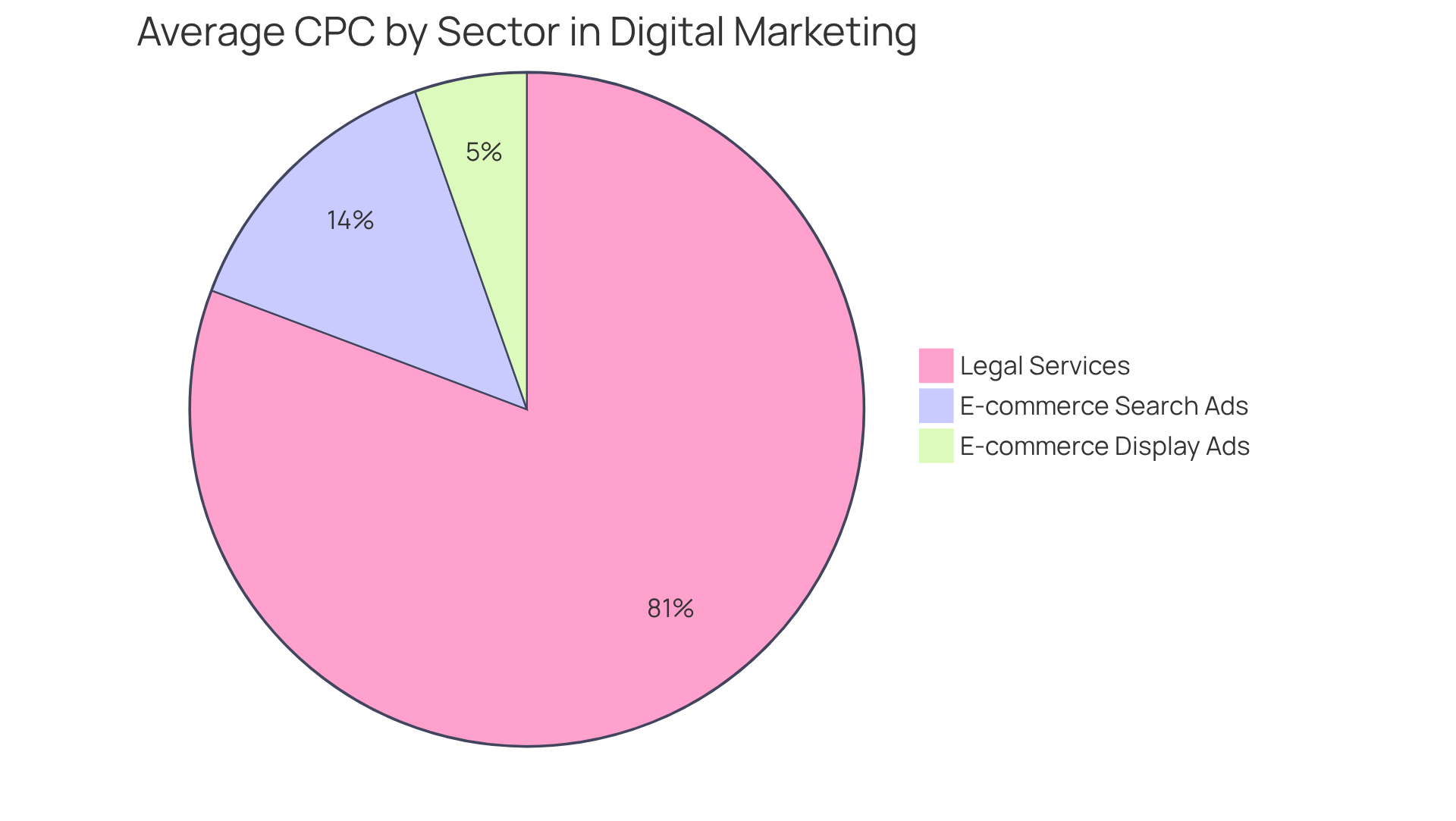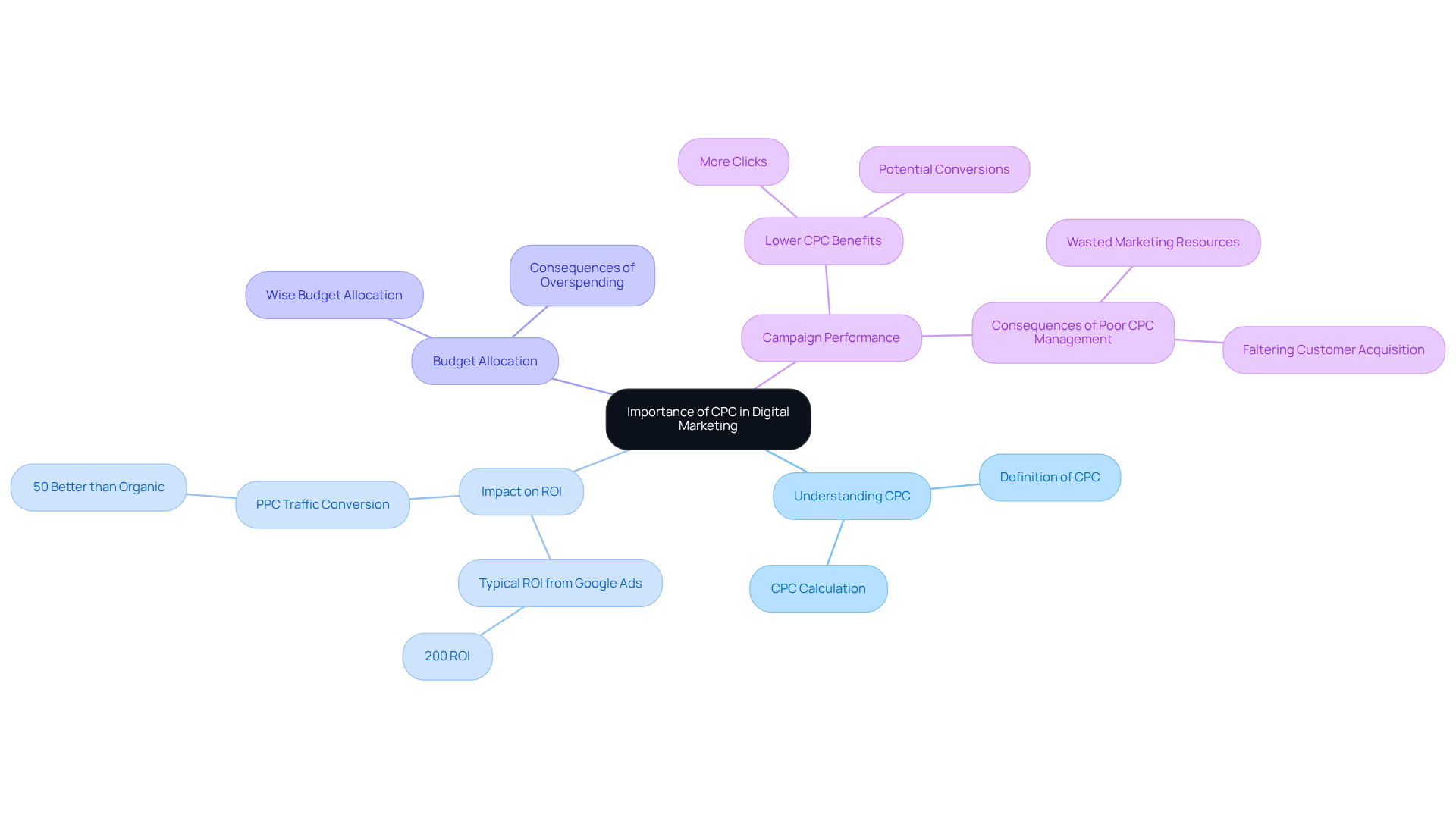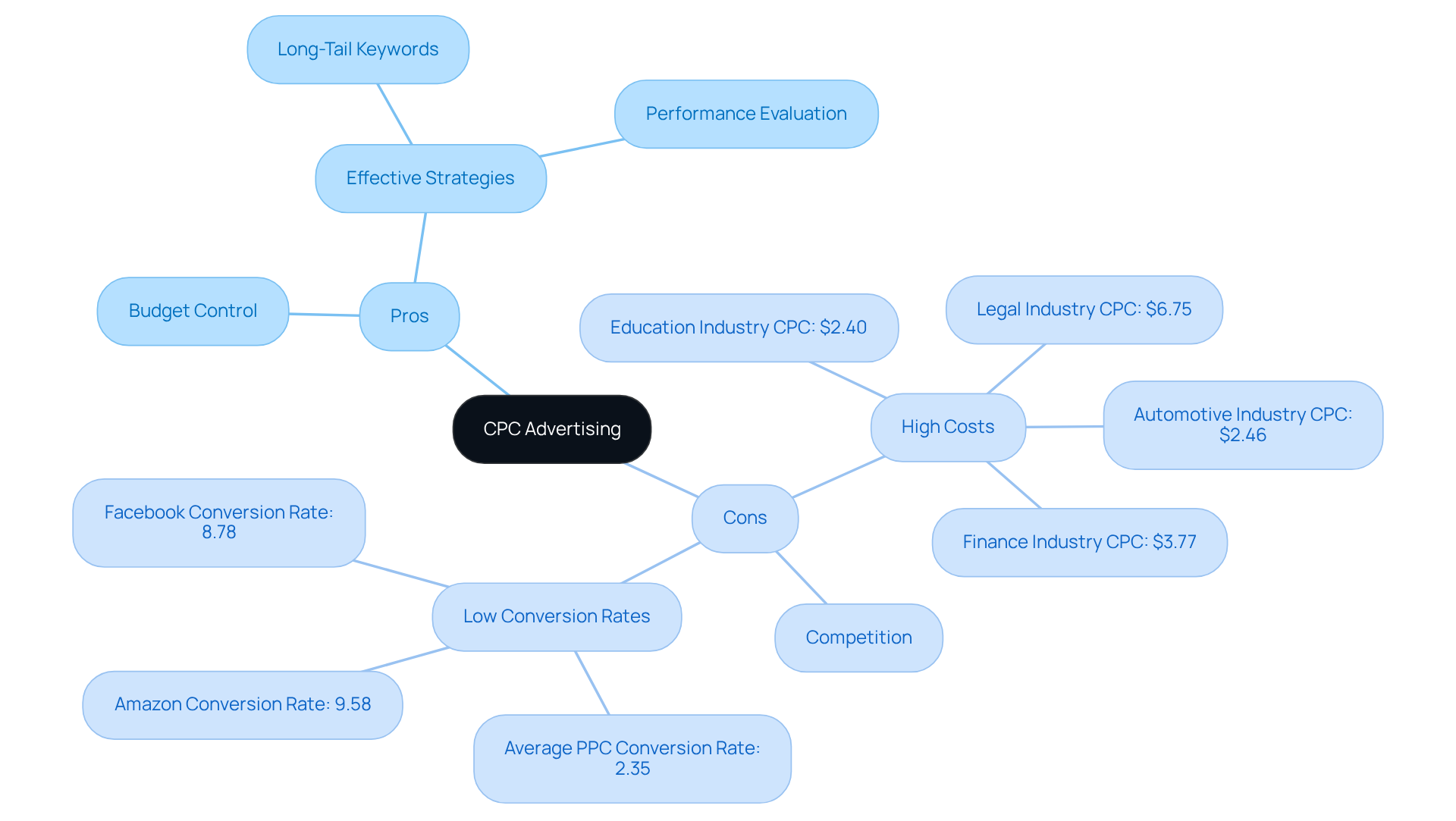Overview
In the world of digital marketing, many tech startup founders face the challenge of effectively managing their advertising costs. The concept of Cost Per Click (CPC) can often feel overwhelming, and without a clear understanding, it can lead to frustration and wasted resources. It's essential to recognize that optimizing CPC is not just a technical task; it's a vital step toward maximizing your return on investment.
Imagine running a campaign that you believe will attract a significant audience, only to find that your costs are spiraling out of control. This is a common concern, and it highlights the importance of understanding how CPC works. By calculating CPC accurately and recognizing its advantages and disadvantages, you can make informed decisions that significantly impact your advertising effectiveness.
At RNO1, we understand the emotional weight that comes with these decisions. Our goal is to provide you with the insights and strategies needed to navigate the complexities of CPC advertising. We have witnessed firsthand how strategic management can transform campaigns, leading to successful outcomes and more efficient use of resources.
We invite you to share your experiences with CPC—what challenges have you faced? By fostering a community of shared knowledge and support, we can work together to turn these challenges into opportunities. Remember, you are not alone in this journey; RNO1 is here to guide you every step of the way.
Introduction
In the ever-evolving world of digital marketing, many advertisers find themselves grappling with the challenge of effectively managing their budgets while striving to maximize returns. This struggle can often feel overwhelming, especially when faced with the complexity of varying Cost Per Click (CPC) rates across different industries. It’s not just about spending money; it’s about investing wisely in opportunities that truly resonate with potential customers. How can marketers navigate this intricate landscape to enhance their advertising strategies, all while avoiding the traps of overspending and ineffective campaigns?
Understanding the nuances of CPC is crucial. It’s a pivotal metric that allows businesses to pay only when potential customers engage with their ads, making it a powerful tool in the digital marketing arsenal. However, the emotional toll of uncertainty can weigh heavily on startup founders, who often bear the brunt of financial pressure. It’s essential to recognize these feelings and address them with compassion.
At RNO1, we believe in not just providing solutions but also in nurturing a supportive community where founders can share their experiences and learn from one another. By leveraging CPC effectively, you can refine your advertising approach, ensuring that every dollar spent is a step toward meaningful engagement and growth. Together, we can explore strategies that align with your unique goals, helping you to navigate this landscape with confidence and clarity.
Define Cost Per Click (CPC)
In the world of digital marketing, many advertisers face the challenge of managing their advertising expenses effectively. What is a CPC? It is a term that can often feel daunting, as it means incurring a fee each time someone clicks on your ad. This model is particularly common in pay-per-click (PPC) promotions, especially on platforms like Google Ads and social media. Understanding is crucial, as it enables advertisers to drive traffic to their websites while paying only when users engage with their ads.
However, the average CPC for Google Ads typically ranges from $1 to $3 across various industries, and it can be even higher in specific sectors. For instance:
- Legal services can see an average CPC of $6.75 for search ads.
- E-commerce businesses may experience CPCs of approximately $1.16 for search and $0.45 for display ads.
These figures can be overwhelming, especially when considering the factors that affect CPC, such as competition for keywords, ad relevance, and overall ad quality. It’s essential to recognize what is a CPC, as it is a critical metric for evaluating the effectiveness of online marketing strategies.
But there is hope. Successful CPC initiatives, like those implemented by brands such as PetMeds, demonstrate the potential of this model when optimized effectively. PetMeds managed to lower their Customer Acquisition Cost (CAC) by 21% while boosting orders by 26% through the use of Northbeam. This example illustrates that with the right approach, brands can thrive in the digital landscape.
As digital marketing continues to evolve, understanding what is a CPC and utilizing it will remain vital for brands seeking to maximize their return on investment. Remember, you are not alone in this journey. Embracing CPC can lead to meaningful connections with your audience and ultimately foster growth for your business.

Explain the Importance of CPC in Digital Marketing
In the world of digital marketing, many tech startup founders grapple with a crucial challenge: understanding what is a CPC. This metric is not just a number; it profoundly impacts your return on investment (ROI) for advertising efforts. When you truly understand what is a CPC, it empowers you to allocate your budget wisely and refine your strategies for maximum effectiveness. A lower CPC often indicates that your ad is resonating well with your audience, leading to more clicks and potential conversions without straining your finances.
However, the implications of not mastering CPC can be daunting. Many startups find themselves overspending on ads that fail to engage their target audience, resulting in wasted marketing resources. This is where the pain points lie—without effective management of CPC, your customer acquisition efforts may falter, and your marketing budget could dwindle faster than anticipated.
But there is hope. By focusing on optimizing your CPC, you can enhance your overall campaign performance and achieve sustainable growth. For instance, businesses can expect a typical ROI of 200% from their Google Ads investments, and did you know that PPC traffic converts 50% more effectively than organic traffic? These insights highlight what is a CPC and its importance as a pathway to profitability.
Currently, the average CPC for Google Ads stands at $4.66. This figure underscores the necessity of managing this metric effectively. Remember, you’re not alone in this journey—many founders have faced similar hurdles and emerged stronger by embracing the art of CPC management. Together, let’s explore strategies that can transform your approach and lead to successful outcomes in .

Detail How to Calculate and Optimize CPC
Calculating Cost Per Click (CPC) can often feel daunting for many marketers, particularly when trying to grasp what is a CPC to make every advertising dollar count. To understand what is a CPC, the process involves dividing the total expenditure of an advertising effort by the number of clicks obtained, which is a straightforward formula: CPC = Total Cost / Total Clicks. For instance, if a marketing effort incurs a cost of $500 and generates 100 clicks, the CPC would be $5. This simple calculation, however, can lead to deeper concerns about the effectiveness of your advertising strategy.
To truly optimize what is a CPC, it’s crucial to . Think about how your ads resonate with your target audience; are they speaking to their needs and desires? Conducting A/B testing can be a game-changer, allowing you to identify which ads perform best. Moreover, leveraging negative keywords can help filter out irrelevant traffic, increasing the likelihood that the clicks you receive convert into loyal customers. These strategies not only improve your CPC but also foster a more meaningful connection with your audience.
Ongoing observation and modification of your strategies based on performance data are essential for understanding what is a CPC in order to maintain an optimal cost per click. As marketing specialist Meghan Parsons emphasizes, adopting a strategic approach to campaign optimization can lead to significant improvements in outcomes, ultimately resulting in measurable success in digital promotion. Remember, you’re not alone in this journey; many have faced similar challenges and found their way through thoughtful adjustments and community support.

Discuss the Pros and Cons of CPC Advertising
For startups, understanding what is a CPC in CPC advertising presents a significant challenge, often leading to feelings of frustration and uncertainty. The high costs associated with competitive keywords can be daunting, especially when precise budget control is essential for fledgling businesses. Advertisers can set daily or monthly budgets, which is a comforting feature that helps prevent overspending, but the reality is that even with these controls, many startups find themselves navigating a complex landscape. For instance, when discussing what is a CPC, the typical cost per click for Google Ads is around $2.69, while industries like automotive and education see CPCs of $2.46 and $2.40, respectively. This competitive environment can feel overwhelming for new entrepreneurs who are just starting out.
The pressure intensifies when considering the high competition for popular keywords, leading to a significant increase in rates, which makes one wonder what is a CPC. Startups with limited budgets may struggle to keep pace, especially in sectors like finance, where understanding what is a CPC is crucial as the typical cost can soar to $3.77, and in the legal industry, it can reach an astonishing $6.75. Such figures can deter smaller players, leaving them feeling discouraged. Moreover, if startups do not understand what is a CPC and manage their efforts effectively, they risk wasting precious resources on clicks that do not convert into sales. With the average conversion rate for PPC ads hovering around a mere 2.35%, compared to 9.58% on Amazon and approximately 8.78% on Facebook, it becomes clear that strategic management is crucial.
To alleviate these challenges, it's vital for marketers to continuously evaluate their initiatives, adapting strategies based on performance data. This proactive approach not only maximizes the return on investment in advertising, specifically what is a CPC, but also ensures that every dollar spent contributes to meaningful engagement and sales growth. Embracing long-tail keywords can be a particularly effective strategy for reducing CPC and enhancing ad placement, making it a relevant consideration for startups. As Aljay Ambos wisely notes, understanding these numbers is essential for building smarter campaigns in . Together, we can navigate these complexities and foster a supportive community that empowers tech startup founders to thrive.

Conclusion
Understanding Cost Per Click (CPC) can feel overwhelming for those navigating the digital marketing landscape. This metric not only dictates how much advertisers pay for each click on their ads but also serves as a crucial indicator of the effectiveness of their marketing strategies. By grasping the nuances of CPC, businesses can optimize their advertising efforts to ensure they achieve maximum engagement and return on investment.
Many advertisers struggle with managing CPC effectively, often feeling the pressure of rising costs and the challenge of standing out in a crowded market. This can lead to frustration and uncertainty about how to improve campaign performance. However, there is hope. By delving into various aspects of CPC—its definition, importance, calculation methods, and the pros and cons associated with CPC advertising—advertisers can find clarity and direction. Key insights reveal that a well-managed CPC can lead to significant savings and improved campaign performance. For instance, successful brands have shown that optimizing CPC can lower customer acquisition costs while increasing sales, highlighting the importance of strategic management in digital campaigns.
Ultimately, mastering CPC is not just about understanding a metric; it is about harnessing its power to drive meaningful connections with audiences and foster business growth. Advertisers are encouraged to embrace the complexities of CPC management, utilizing tools and strategies that can transform their advertising approach. By doing so, they can navigate the competitive digital landscape with confidence, ensuring that every click contributes to their overarching goals. Remember, you are not alone in this journey—embracing the intricacies of CPC management can lead to a brighter, more successful future for your business.
Frequently Asked Questions
What does Cost Per Click (CPC) mean in digital marketing?
Cost Per Click (CPC) is a term that refers to the fee incurred each time someone clicks on an advertisement. It is a common model used in pay-per-click (PPC) promotions on platforms like Google Ads and social media.
Why is understanding CPC important for advertisers?
Understanding CPC is crucial for advertisers as it enables them to manage their advertising expenses effectively, drive traffic to their websites, and ensure they only pay when users engage with their ads.
What is the average CPC for Google Ads?
The average CPC for Google Ads typically ranges from $1 to $3 across various industries. However, it can be higher in specific sectors.
What are some examples of average CPC in different industries?
In the legal services industry, the average CPC for search ads can be around $6.75. For e-commerce businesses, the average CPC is approximately $1.16 for search ads and $0.45 for display ads.
What factors can affect CPC?
Factors that can affect CPC include competition for keywords, ad relevance, and overall ad quality.
Can successful CPC initiatives lead to better marketing outcomes?
Yes, successful CPC initiatives can lead to improved marketing outcomes. For example, PetMeds managed to lower their Customer Acquisition Cost (CAC) by 21% while increasing orders by 26% through effective CPC strategies.
How does understanding CPC contribute to a brand's growth?
Understanding and utilizing CPC effectively allows brands to maximize their return on investment, foster meaningful connections with their audience, and ultimately promote growth for their business.




